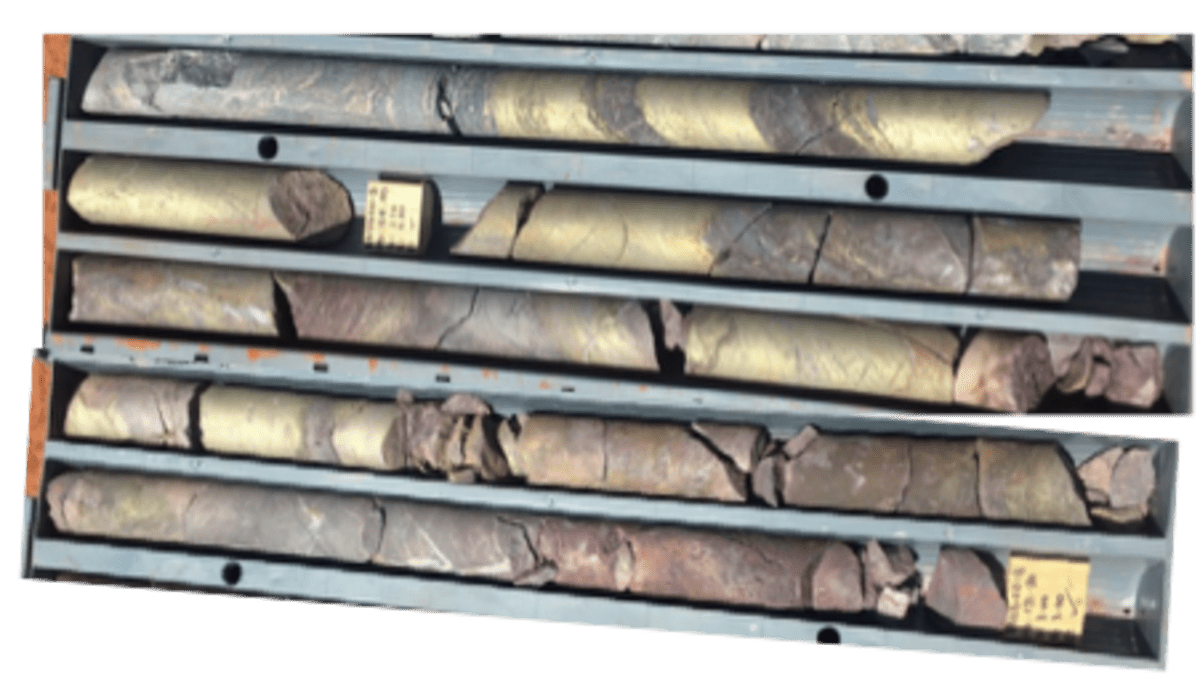Tennant drilling extends Bluebird copper sulphide mineralisation

Massive chalcopyrite (copper-sulphide) from Tennant's latest drillhole at Bluebird Pic: Supplied
Step-out drilling at Tennant’s Bluebird copper-gold discovery within its Barkly project appears to have got off to a fabulous start with the first hole intersecting massive copper sulphides.
Hole BBDD0018 – the first new hole in its Stage 2 drill program – intersected a 7m zone containing 60% massive copper sulphides (chalcopyrite and minor chalcocite) within a broader 32.5m intensely haematite-copper mineralised zone.
While assays will be required to determine exactly what is present within the mineralised interval, the result is nonetheless hugely positive for Tennant Minerals (ASX:TMS) given that it extends the upper dilational zone at Bluebird west of previous thick, high-grade copper intersections.
This previous drilling had returned assays such as 63m at 2.1% copper and 4.6 grams per tonne (g/t) from a down-hole depth of 153m including 27.55m at 3.6% copper and 10g/t gold (BBDD0012) and 40m at 2.6% copper and 1.34g/t gold from 131m including 4.75m at 15.2% copper (BBDD0013).
Further drilling in the 10 hole program totalling 3,000m will now seek to extend this zone towards the induced polarisation low resistivity / high-chargeability target identified about 80m west of Bluebird.
Additionally, the current hole (BBDD0019) will test deeper extensions of the Bluebird discovery, where the deepest intersection to date – 17.8m at 3.7% copper and 0.34g/t gold from 277m – indicates proximity to a second dilational (thickened) zone at depth.
Should drilling confirm the presence of a second thickened zone at depth and extensions to the west, the company would have significant potential to define a multi-million tonne resource at Bluebird that could rival the nearby Peko deposit which has past production of 3.7Mt at 4% copper and 3.5g/t gold.
Bluebird and the Barkly project
The Barkly project is located at the eastern edge of the Tennant Creek Mineral Field which has seen production of over 5Moz of gold and 500,000t of copper from 1934 to 2005.
Bluebird is one of the multiple targets identified within the project along a 5km east-west trending gravity anomaly (the Bluebird Corridor) defined by Tennant.
Its latest diamond drilling intersection extends the thick high-grade zone of mineralisation at Bluebird 20m to the west.
Additionally, interpretation of key drilling intersections indicates that the thick intersections in BBDD0012 and BBDD0013 are associated with steeply-dipping structures that have intersected and “rolled-over” the axis of a shallow-plunging anticline, generating a thick dilational mineralised zone.
Up to seven holes in Stage 2 will test the steeply plunging zone at Bluebird to more than 400m below surface, and to also test for a second dilational zone immediately below BBDD0013.
An additional three drillholes will test the strong IP anomaly to the west.
Further IP traverses completed over the 12 gravity-magnetic targets, identified within the 2km Bluebird-Perseverance Target Zone 4, have produced low-resistivity/high-chargeability anomalies similar to Bluebird in at least three target areas.
Modelling of the IP data is in progress and a second drilling rig has been mobilised to carry out further drilling to test the priority copper-gold targets identified from the magnetics and gravity modelling as well as the IP survey, within the Bluebird-Perseverance Target Zone.
This article was developed in collaboration with Tennant Minerals, a Stockhead advertiser at the time of publishing.
This article does not constitute financial product advice. You should consider obtaining independent advice before making any financial decisions.
Related Topics

UNLOCK INSIGHTS
Discover the untold stories of emerging ASX stocks.
Daily news and expert analysis, it's free to subscribe.
By proceeding, you confirm you understand that we handle personal information in accordance with our Privacy Policy.








